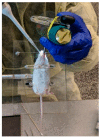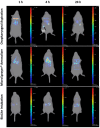Respiratory Tract Deposition and Distribution Pattern of Microparticles in Mice Using Different Pulmonary Delivery Techniques
- PMID: 29996506
- PMCID: PMC6161314
- DOI: 10.3390/vaccines6030041
Respiratory Tract Deposition and Distribution Pattern of Microparticles in Mice Using Different Pulmonary Delivery Techniques
Abstract
Pulmonary delivery of drugs and vaccines is an established route of administration, with particulate-based carriers becoming an attractive strategy to enhance the benefits of pulmonary therapeutic delivery. Despite the increasing number of publications using the pulmonary route of delivery, the lack of effective and uniform administration techniques in preclinical models generally results in poor translational success. In this study, we used the IVIS Spectrum small-animal in vivo imaging system to compare the respiratory tract deposition and distribution pattern of a microsphere suspension (5 µm) in mice after 1, 4, and 24 h when delivered by oropharyngeal aspiration, the Microsprayer® Aerosolizer, and the BioLite Intubation System, three-widely reported preclinical inhalation techniques. We saw no significant differences in microsphere deposition in whole body images and excised lungs (at 1, 4, and 24 h); however, the three-dimensional (3D) images showed more localized deposition in the lungs with the MicroSprayer® and BioLite delivery techniques. Further, oropharyngeal aspiration (at 1 h) showed microsphere deposition in the oral cavity, in contrast to the MicroSprayer® and BioLite systems. The studies shown here will allow researchers to choose the appropriate pulmonary delivery method in animal models based on their study requirements.
Keywords: BioLite intubation; IVIS; MicroSprayer® Aerosolizer; microparticles; oropharyngeal aspiration; pulmonary delivery; respiratory tract deposition; vaccines.
Conflict of interest statement
The authors declare no conflict of interest.
Figures









Similar articles
-
Comparison of the local pulmonary distribution of nanoparticles administered intratracheally to rats via gavage needle or microsprayer delivery devices.J Appl Toxicol. 2017 Apr;37(4):502-507. doi: 10.1002/jat.3386. Epub 2016 Oct 6. J Appl Toxicol. 2017. PMID: 27714835
-
Preclinical evaluation of aerosol administration systems using Positron Emission Tomography.Eur J Pharm Biopharm. 2018 Sep;130:59-65. doi: 10.1016/j.ejpb.2018.05.037. Epub 2018 May 31. Eur J Pharm Biopharm. 2018. PMID: 29859808
-
Aerosol-Based Cell Therapy for Treatment of Lung Diseases.Methods Mol Biol. 2016;1516:243-255. doi: 10.1007/7651_2016_327. Methods Mol Biol. 2016. PMID: 27062596
-
Mechanisms of pharmaceutical aerosol deposition in the respiratory tract.AAPS PharmSciTech. 2014 Jun;15(3):630-40. doi: 10.1208/s12249-014-0092-0. Epub 2014 Feb 22. AAPS PharmSciTech. 2014. PMID: 24563174 Free PMC article. Review.
-
Patented therapeutic drug delivery strategies for targeting pulmonary diseases.Expert Opin Ther Pat. 2020 May;30(5):375-387. doi: 10.1080/13543776.2020.1741547. Epub 2020 Mar 21. Expert Opin Ther Pat. 2020. PMID: 32178542 Review.
Cited by
-
Carbon Nanotubes as Carriers in Drug Delivery for Non-Small Cell Lung Cancer, Mechanistic Analysis of Their Carcinogenic Potential, Safety Profiling and Identification of Biomarkers.Int J Nanomedicine. 2022 Dec 8;17:6157-6180. doi: 10.2147/IJN.S384592. eCollection 2022. Int J Nanomedicine. 2022. PMID: 36523423 Free PMC article. Review.
-
Method for Pulmonary Administration Using Negative Pressure Generated by Inspiration in Mice.Pharmaceutics. 2020 Feb 25;12(3):200. doi: 10.3390/pharmaceutics12030200. Pharmaceutics. 2020. PMID: 32106551 Free PMC article.
-
Optimizing anesthesia and delivery approaches for dosing into lungs of mice.Am J Physiol Lung Cell Mol Physiol. 2023 Aug 1;325(2):L262-L269. doi: 10.1152/ajplung.00046.2023. Epub 2023 Jul 4. Am J Physiol Lung Cell Mol Physiol. 2023. PMID: 37401383 Free PMC article.
-
Aerosol pulmonary immune engineering.Adv Drug Deliv Rev. 2023 Aug;199:114831. doi: 10.1016/j.addr.2023.114831. Epub 2023 Apr 24. Adv Drug Deliv Rev. 2023. PMID: 37100206 Free PMC article. Review.
-
Comparative Evaluation of Lipopolysaccharide Administration Methods to Induce Acute Lung Injury in Murine Models: Efficacy, Consistency, and Technical Considerations.Crit Care Explor. 2025 Jul 28;7(8):e1292. doi: 10.1097/CCE.0000000000001292. eCollection 2025 Aug 1. Crit Care Explor. 2025. PMID: 40720189 Free PMC article.
References
LinkOut - more resources
Full Text Sources
Other Literature Sources

